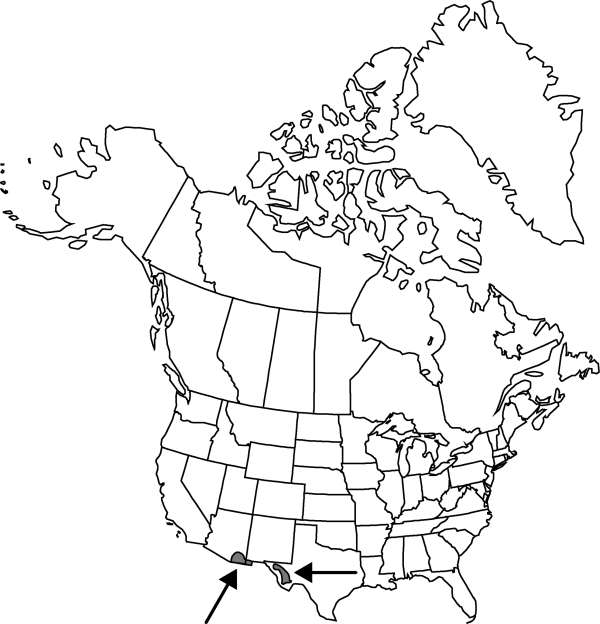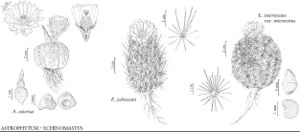familyCactaceae
subfamilyCactaceae subfam. Cactoideae
genusEchinomastus
speciesEchinomastus intertextus
Difference between revisions of "Echinomastus intertextus var. intertextus"
FNA>Volume Importer |
FNA>Volume Importer |
||
| Line 12: | Line 12: | ||
}}<!-- | }}<!-- | ||
| − | --><span class="statement" id="st- | + | --><span class="statement" id="st-undefined" data-properties=""><b>Stems </b>spheric when young, ovoid to ovoid-cyli ndric with age, appearing smooth and easily handled. <b>Spines</b> closely appressed, except for the porrect abaxial central spine, which is 0.5–4(–5) mm. <b>2n</b> = 22.</span><!-- |
-->{{Treatment/Body | -->{{Treatment/Body | ||
| + | |phenology=Flowering Feb–Apr; fruiting Apr–Jun. | ||
|habitat=Desert grasslands and plains grasslands, grassy hills, bajadas, sometimes with junipers or oaks, on igneous substrates (rarely limestone) | |habitat=Desert grasslands and plains grasslands, grassy hills, bajadas, sometimes with junipers or oaks, on igneous substrates (rarely limestone) | ||
|elevation=1000-1900 m | |elevation=1000-1900 m | ||
| Line 34: | Line 35: | ||
|basionyms= | |basionyms= | ||
|family=Cactaceae | |family=Cactaceae | ||
| + | |phenology=Flowering Feb–Apr; fruiting Apr–Jun. | ||
|habitat=Desert grasslands and plains grasslands, grassy hills, bajadas, sometimes with junipers or oaks, on igneous substrates (rarely limestone) | |habitat=Desert grasslands and plains grasslands, grassy hills, bajadas, sometimes with junipers or oaks, on igneous substrates (rarely limestone) | ||
|elevation=1000-1900 m | |elevation=1000-1900 m | ||
| Line 41: | Line 43: | ||
|publication year= | |publication year= | ||
|special status= | |special status= | ||
| − | |source xml=https://jpend@bitbucket.org/aafc-mbb/fna- | + | |source xml=https://jpend@bitbucket.org/aafc-mbb/fna-data-curation.git/src/9216fc802291cd3df363fd52122300479582ede7/coarse_grained_fna_xml/V4/V4_369.xml |
|subfamily=Cactaceae subfam. Cactoideae | |subfamily=Cactaceae subfam. Cactoideae | ||
|genus=Echinomastus | |genus=Echinomastus | ||
|species=Echinomastus intertextus | |species=Echinomastus intertextus | ||
|variety=Echinomastus intertextus var. intertextus | |variety=Echinomastus intertextus var. intertextus | ||
| − | |||
| − | |||
| − | |||
| − | |||
| − | |||
| − | |||
| − | |||
}}<!-- | }}<!-- | ||
-->[[Category:Treatment]][[Category:Echinomastus intertextus]] | -->[[Category:Treatment]][[Category:Echinomastus intertextus]] | ||
Revision as of 14:08, 27 July 2019
Stems spheric when young, ovoid to ovoid-cyli ndric with age, appearing smooth and easily handled. Spines closely appressed, except for the porrect abaxial central spine, which is 0.5–4(–5) mm. 2n = 22.
Phenology: Flowering Feb–Apr; fruiting Apr–Jun.
Habitat: Desert grasslands and plains grasslands, grassy hills, bajadas, sometimes with junipers or oaks, on igneous substrates (rarely limestone)
Elevation: 1000-1900 m
Distribution

Ariz., N.Mex., Tex., Mexico (Chihuahua).
Discussion
Most published records of Echinomastus intertextus from central New Mexico, and many from southern New Mexico, probably pertain to var. dasyacanthus; the varieties replace each other geographically, but many populations in south-central New Mexico may be intermediate, containing long-, medium-, and short-spined individuals. Although not documented for Sonora, var. intertextus is known less than one kilometer from the Mexican border in southeastern Arizona.
Selected References
None.
Lower Taxa
None.
... more about "Echinomastus intertextus var. intertextus"
